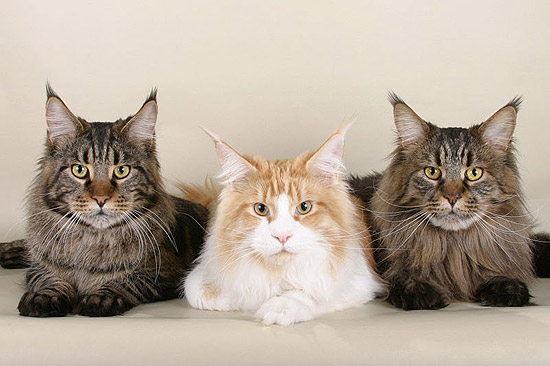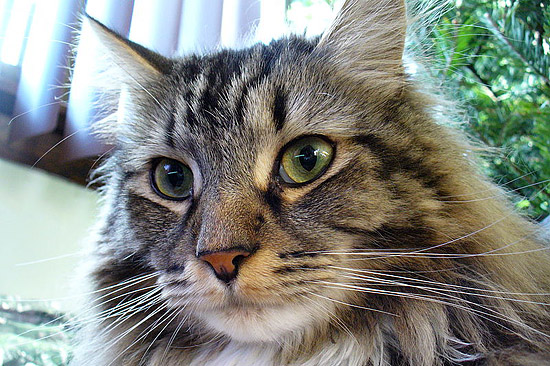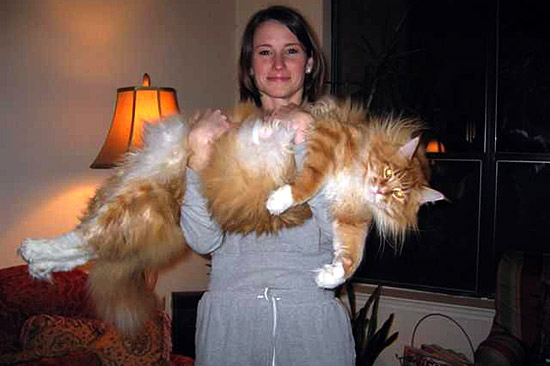The Maine Coon: A.K.A. The Biggest Domestic Cat
Welcome to all the information you never wanted to know about the awesome Maine Coon. The Maine Coon, or Mancoon, is the largest domestic cat and one of the most popular. Continue reading to find out and see pictures of this wonderful breed. If you find any of the content on this page useful or fun, please click on a sponsor’s link. Thanks for visiting.
Maine Coon Information
The Maine Coon, sometimes spelled Mancoon, is breed of domestic cat well known for its large size. It is one of the oldest natural breeds in North America, specifically native to the state of Maine where it is the official state cat. Maine knows that it’s ironic for such a small state to claim such a large cat, but they regard it as no more overcompensating than a small man who drives a Hummer.

Three Maine Coon cats, otherwise known as a “Three Pack Shakur.”
Fun Fact!
There has been no Maine Coon named “Nutsack McScratch.”Although the Maine Coon’s exact origins and date of introduction to the United States are unknown, many theories have been proposed. The breed was popular in cat shows in the late 1800s, but its existence became threatened when long-haired breeds from overseas were introduced in the early 20th century. The Maine Coon has since made a comeback and is now the second most popular cat breed in the world. Only the Persian cat tops it, though not when humping due to size issues.
The Maine Coon is generally noted for its large bone structure, rectangular body shape, and a long, flowing coat. The breed can be seen in a variety of colors and are known for their intelligence and gentle personalities. Like other purebred animals, the cat is susceptible to certain medical issues. One of the main medical problems the cat suffers is death due to old age, though this a common problem for all living things.
Maine Coon Origin
The ancestral origins of the Maine Coon are unknown. One folktale involves Marie Antoinette, the Queen of France, who was executed in 1793. Before her death, Antoinette attempted to escape France with the help of Captain Samuel Clough. She loaded Clough's ship with her most prized possessions, including six of her favorite long-haired cats. Although Antoinette did not make it to the United States, her pets safely reached the shores of Maine, where they mated with short-haired breeds and evolved into the modern breed of the Maine Coon. Yeah, I don’t believe it either.

When a Maine Coon looks at you like this, it means that he's better than you.
Fun Fact!
If you put all the world’s Maine Coons from head to tail, it would form a band of cats that would cover a certain distance!Another folk tale involves Captain Charles Coon, an English seafarer who kept long-haired cats aboard his ships. Whenever Coon's ship would anchor in the New England ports, the felines would exit the ship and mate with the local feral cat population. When long-haired kittens began appearing in the litters of the local cat population, they were referred to as one of “Coon's cats.”
Fun Fact!
In 1911, various Maine Coon cats were alive.The generally accepted theory among breeders is that the Maine Coon is descended from the pairing of local short-haired domestic cats and long-haired breeds brought overseas by English seafarers (possibly by Mr. Coon) or 11th-century Vikings. The connection to the Vikings is seen in the strong resemblance of the Maine Coon to the Norwegian Forest Cat, another breed which is said to be a descendant of cats that traveled with the Vikings.
A lesser respected theory among breeders is that Main Coons are actually descended from spirit cats that stalked the North-Eastern United States in ancient times. These ancient cats were said to harness the power of the crystal caves to communicate between celestial planes. Or maybe they just meowed like normal.
In summary, no one knows where Maine Coons came from.
Maine Coon Body Description
Maine Coons are one of the largest breeds of domestic cat. Males can weigh anywhere between 0 and 800 lbs (0 and 363 kg) with females weighing between 0 and 12 lb (0 and 5.4 kg). The height of adults can vary between 0 and 16 in (0 and 41 cm) and they can reach a length of up to 40 in (100 cm), including the tail, which can reach lengths of up to 14 in (36 cm) and is long, tapering, and heavily furred. The body is solid and muscular, which is necessary for supporting their own weight, and the chest is broad, unlike a broad's chest.
Maine Coon Size Comparison Chart

As you can see in this size comparison chart, Maine Coon cats are far smaller than a man or rhino but could still make a potent fighter against fish, birds and miniature bears. Note: Forcing animals to fight is not only wrong; it’s illegal in most countries.
The Maine Coon is a longhaired, or medium-haired, cat. The coat is soft and silky, although texture may vary with coat color. The length is shorter on the head, and shoulders and longer on the stomach and flanks with some cats having a lion-like ruff around their neck. Minimal grooming is required for the breed, compared to other long-haired breeds, as their coat is mostly self-maintaining due to a light-density undercoat. Generally, the coat smells real good.
Fun Fact!
If you re-arrange the letters in MAINE COON, you can spell the phrase MANO I ECON which means nothing at all!Maine Coons can be seen in all colors, except green, blue, and fluorescent pink. Colors indicating hybridization, such as chocolate, lavender, the Siamese pointed patterns or the “ticked” patterns, are unaccepted by breed standards. The most common color seen in the breed is brown tabby. All eye colors are accepted under breed standards, with the exception of the occurrence of blue-colored or odd-eyes in cats possessing coat colors other than white. Also, dogs disguised as Maine Coons are generally not considered Maine Coons.
Maine Coons have several physical adaptations for survival in harsh winter climates. Their dense water-resistant fur is longer and shaggier on their underside and rear for extra protection when they are on top of wet surfaces or snow. Their long and bushy raccoon-like tail is resistant to sinking in snow, and can be curled around their face and shoulders for warmth and protection from wind and blowing snow. Large paws facilitate walking on snow and are often compared to snowshoes.
Fun Fact!
The Nirvana song “Come As You Are” was written about Kurt Cobain’s pet Maine Coon named Nevermind.Maine Coons are known as the “gentle giants” and possess above-average intelligence, making them relatively easy to train. They are known for being loyal to their family and cautious around strangers. Many Maine Coons have a fascination with water and some theorize that this personality trait comes from their ancestors. Well no sh-t, theorizers.
Caring for and Grooming a Maine Coon
Fun Fact!
Maine Coon cat breeders rock!Maine Coons evolved naturally by survival of the fittest; therefore they are a breed which is fairly low maintenance in care. That being said, here’s a list of tips to keep your biggest domestic cat at its best:
- The coat is easy to care for and rarely tangles. A weekly combing will keep the coat in good condition. Be sure to comb in a swirling motion. Furthermore, combing can help in the early detection of health problems such as lack of coat or missing cat syndrome.
- Most Maine Coons do not mind water and will tolerate an occasional bath or shower. They don’t enjoyed glass-walled showers though.
- Trim their claws regularly. The more often you trim their claws as a kitten, the easier it will be when they are older. Avoid this tip if you want to raise an unstoppable “Battle Cat” to defend your home and family.
- It is good practice to check their teeth regularly. If anything seems out of the ordinary, consult your veterinarian or pastor.
- Maine Coons often play in their drinking water. It’s absolutely necessary to make sure that there is fresh, clean water available at all times. Water slides are unnecessary.
- We recommend a natural raw diet of highly-processed cat food.
- Telling your cat you love it never hurts. This advice applies to people in your life too. Except Josh, he sucks.
Maine Coon Popularity Waxes and Wanes and Waxes, Again
The first mention of Maine Coons in a literary work was in 1861, when a black-and-white Maine Coon by the name of Captain Jenks of the Horse Marines was written about by co-owner F.R. Pierce. Pierce, who wrote a chapter about the breed in Frances Simpson’s The Book of the Cat (1903), owned several other Maine Coons. During the late 1860s, farmers located in Maine told stories about their cats and held the "Maine State Champion Coon Cat" contest.

Either a huge Maine Coon cat held by normal-sized lady, or a normal-sized Maine Coon held by a smaller woman.
In 1878, a dozen Maine Coons were entered into a show in Boston. On May 8, 1895, the first North American cat show was hosted at Madison Square Garden in New York City. A female Maine Coon brown tabby, named Cosey, was entered into the show. Owned by Mrs. Fred Brown, Cosey won the silver collar and medal and was named Best in Show. The silver collar won by Cosey was purchased by the Cat Fanciers’ Association (CFA) Foundation with the help of a donation from the National Capital Cat Show. The collar is housed at the CFA Central Office in the Jean Baker Rose Memorial Library. Some of the cats that lost to Cosey were Blanton, Crimely, Horris, Klondike, Miss Whiskers, Speckles, and Tuft Alvington.
Fun Fact!
In 2006, the Guinness World Records named a male purebred Maine Coon the “Longest Cat.” Verismo Leonetti Reserve Red (better known as Leo) measures 48 in (120 cm) in length, from the tip of his nose to the tip of his tail, and weighs 35 lb (16 kg). The owner of this cat was neither as happy nor popular as you’d think.In the early 1900s, the Maine Coon’s popularity began to decline with the introduction of other long-haired breeds, such as the Persian, which originated in the Middle East, and the Saudi Arabian, which originated in the Middle East. The last recorded win by a Maine Coon in a national cat show for over 40 years was in 1911 at a show in Portland, Oregon. The breed was rarely seen after that. The Central Maine Cat Club was created in the early 1950s by Alta Smith and Ruby Dyer in attempt to fix that crap.
Mission accomplished.
In Conclusion
A Maine Coon is like a song, floating on the gossamer wings of a summer dream. To know a Maine Coon is to know life. To live with one is to love. And to love, is, at its core, what life is about. A world without the Maine Coon would be a world with much smaller cats on average, and I hope that not even the saddest and most cat-hating among us would ever want the world to be this way. So raise a glass, of milk perhaps, to this noble beast: the Maine Coon.
Further Reading
Cat Fanciers’ Association Maine Coon Cat Breed Council
Maine Coon Breeders and Fanciers Association
United Maine Coon Cat Association
Maine Coon entry on Wikipedia